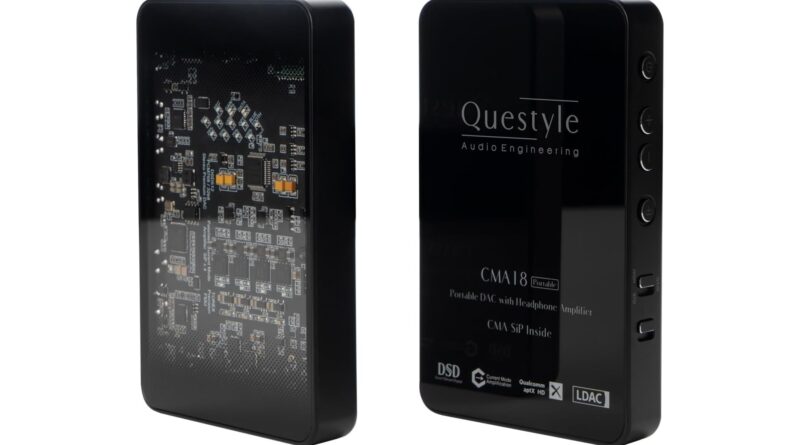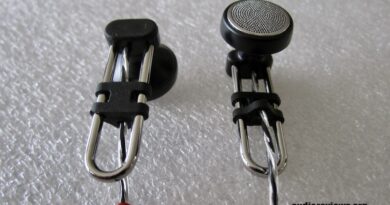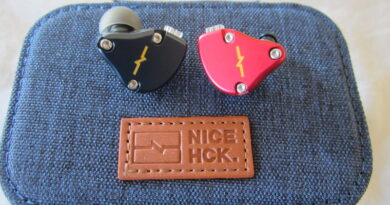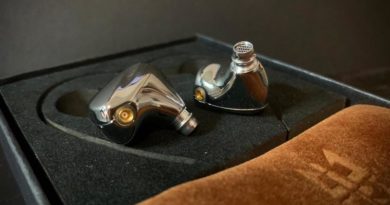Questyle CMA18 Portable Review – Right Size, Good Sound
I was particularly intrigued when Questyle announced their first battery-based portable DAC-AMP: would that be on par with their outstanding QP DAPs soundwise? So it was with great curiosity that I took the plunge into assessing their CMA18 Portable, a wonderful-looking, elegant, lightweight little box which is so easy to pocket and carry around.
Surprisingly, and uncommonly, CMA18 Portable is not a mere DAC-AMP, it’s rather similar to a full audio interface thanks to its built-in ADC capabilities. As this part is not – or not yet? – my cup of tea, it won’t be part of my analysis.
At this review time CMA18 Portable can be purchased for $699.00 from Questyle central shop with free worldwide shipping. As always, the link is non-affiliated.
In this Article
At-a-glance Card
| PROs | CONs |
| Spectacular imaging, layering and separation | Noise floor / hiss on high and medium-high sensitivity loads |
| Very good range extension | Modest current delivery vs x-low sensitivity loads |
| Good spatial drawing | High mids and trebles may feel a bit grainy |
| BT and optical digital input support | Back and front (glass) panels seem fragile |
| Spot-on size and weight for portable/pocketable use | |
| Built-in ADC dramatically widens applicative horizons | |
| Generous accessories package |
I am not writing these articles to help manufacturers promote their products, even less I’m expecting or even accepting compensation when I do. I’m writing exclusively to share my fun – and sometimes my disappointment – about gear that I happen to buy, borrow or somehow receive for audition.
Another crucial fact to note is that I have very sided and circumscribed musical tastes: I almost exclusively listen to jazz, and even more particularly to the strains of post bop, modal, hard bop and avantgarde which developed from the late ’50ies to the late ’70ies. In audio-related terms this implies that I mostly listen to musical situations featuring small or even very small groups playing acoustic instruments, on not big stages.
One of the first direct consequences of the above is that you should not expect me to provide broad information about how a certain product fares with many different musical genres. Oppositely, you should always keep in mind that – different gear treating digital and analog sound in different ways – my evaluations may not, in full or in part, be applicable to your preferred musical genre.
Another consequence is that I build my digital library by painstakingly cherry-pick editions offering the least possible compression and pumped loudness, and the most extended dynamic range. This alone, by the way, makes common music streaming services pretty much useless for me, as they offer almost exclusively the polar opposite. And, again by the way, quite a few of the editions in my library are monoaural.
Additionally: my library includes a significant number of unedited, very high sample rate re-digitisations of vinyl or open-reel tape editions, either dating back to the original day or more recently reissued under specialised labels e.g. Blue Note Tone Poet, Music Matters, Esoteric Jp, Analogue Productions, Impulse! Originals, and such. Oppositely, I could ever find an extremely small number of audible (for my preferences) SACD editions.
For my direct and conclusive experience, virtually none of the above is available on the most common streaming platforms, which makes their offering of high sampling material apriori pointless for my purposes. Quite simply, then, I don’t use streaming services as I find them not up to my requested quality.
My source gear is on its turn selected to grant very extended bandwidth, high reconstruction proweness, uncolored amping. Which in particularly means that TWS and any other form of lossless-based wireless gear is apriori off my selection panel.
And finally, my preferred drivers (ear or headphones) are first and foremost supposed to feature solid note-body timbre, and an as magically centered compromise between fine detail, articulated texturing and microdynamics as their designers can possibly achieve.
In terms of presentation, for IEMs I prefer one in the shape of a DF curve, with some very moderate extra pushup in the midbass. Extra sub-bass enhancement is totally optional, and solely welcome if seriously well controlled. Last octave treble is also welcome from whomever is really able to turn that into further spatial drawing upgrade, all others please abstain.
Features and description
Build and structure
I like the shape and size of CMA18 Portable. A lot so, too. It’s almost precisely as wide as smartphone, shorter in length, and a bit shy of twice the thickness. Moreover, it’s perfectly flat and regular shaped, which is a glowing invitation to physically “pair” it (“clip” it?) onto the smartphone’s back panel, ready to appreciate how its length is very likely such as not to conflict with backside camera lenses.
I do not like the build, however. Aesthetically pleasing, if you want a bit (too much?) scenographic due to glass showing off the PCB, the components and all those LEDS, it nevertheless leaves you with an uncomfortable sensation of flimsiness. It’s not – or at the very least you are not ready to bet it is – as sturdy as you want it to be to bear the odds of “daily smartphone pairing”, especially if you are like me used to tossing, if not too energically, the smartphone on the desk instead of “delicately laying” it on, or quickly grabbing and dropping it into a coat’s pocket without caring how many keys or other items already are there.
User interface
CMA18 Portable’s user interface is I guess a love or hate case. I tend to be on the former category – caveat though: I’m Mojo-vaccinated…
Physical buttons are well positioned, and not too much “multitasked”.
Via side buttons you can turn the device on/off, check current battery level, regulate volume, select input channel (3.5mm or 4.4mm for ADC, digital USB, digital optical or BT), and set Low / High gain.
I love the “Lock” switch, clearly recalling the same-purpose slider I can find on my Sony DAPs, disabling all buttons which I find crucial to support operation while the device is casually pocketed or carried (loose) inside a shoulderbag or such.
LEDs are a bit too many for my reather sobre tastes, yet not too few as to be (too much) forced to communicate by means of different coloration either. The Gain led turns Yellow/Red dependig on Low/High setting. The DATA led turns Red from Yellow when digital data is actually being received. Etcetera.
The markings on the PCB next to the LEDs are supposed to help make easy sense of each LED purpose… if you can read them, that is. Simply put, they are too small to be supportive of my dry eye condition, ymmv (hopefully for you).
Inputs
CMA18 Portable accepts digital input via the USB-C port (which is also use for charging), and via the left-side 3.5mm jack, in form of optical signal. An optical adapter is bundled within the generous accessories package.
The device also offers analog inputs – a 3.5mm single ended and a 4.4mm balanced port – which are exclusively aimed at feeding its intenal Analog to Digital Converter: CMA18 Portable can in facts be also used as an analog-to-digital recording device, for example to help digitise vinyl records, or even live performances (via a mixing console).
As I mentioned, such analog ports are only there to act as inputs for the ADC module inside CMA18 Portable, wich sadly can’t be operated as a mere portable amplifier. Too bad.
Battery
CMA18 Portable carries an 4300mAh battery, which taken per se of course is meaningless data. What matters is how much such battery will last upon “ordinary” use.
My use case refers (and is limited to) USB connectivity, playback of mostly high-res (88 / 96 / 192Khz( FLAC or DSD (64, 128 and some occasional 256) tracks onto mid-demanding drivers (eg. Sennheiser IE900, Intime Miyabi, Final B3…) at not too loud SPL. In such scenario I could count on a good 8 hours of charge.
Talking about battery, one nice feature of CMA18 Portable is that it defaults to not allowing charging while playing: the device will charge only when the connected USB cable does not carry data together with power, otherwise it will accept the data but not the power. It is however possible to enable “charge while playing” mode by long-pressing the menu button for more than 4 seconds. Neat.
User experience and sound performance
As I mentioned above, the CMA18 Portable features size, shape and weight which are 100% commendable for its main intended use case, being carrying it on yourself, paired with some sort of transport – typically: the smartphone – while commuting, or even walking around.
In terms of sound CMA18 Portable offers commendable bilateral extension, with particular regards to sub-bass. Depending on paired drivers, one can observe meaty – sometimes a bit above organic level – mid bass, and energetic yet sometimes a bit grainy treble. Such mentioned “limitations” are, indeed, subtleties.
The area where CMA18 Portable is truly outstanding is layering and separation, which are at absolute market top levels here, comparable with serious desktop alternatives, e.g. Questyle’s own CMA-400i, which is still better than CMA18 Portable on this respect, but by much.
Lastly. the part where I was expecting more from CMA18 Portable is output power.
In terms of voltage swing, it proves sufficient – but not much more than that – to adequately drive HD800. A bit more overhead on those Sennies can be added by switching High Gain on, but – as it too often happens – that results in a very hearble dynamic range compression, which I tend to stay as far as possible when listinening to my preferred acoustic tacks. Anyhow, Low Gain is enough for HD800, so be it.
On the opposite end, current delivery vs low sensitivity loads – especially at low impedances – could definitely use a boost. Taking the “usual” acid test, CMA18 Portable turns out to be a not ideal pair for Final E5000 – to give an idea, Questyle’s own flagship dongle, the M15 / M15i, deliver much more power into E5000 and make their sound open up much more organically, while they stay dark and closed-in when plugged onto CMA18 Portable.
Specifications
Physicals:
- Case: Aviation aluminum CNC sandblasting, Corning custom glass
- Dimensions: 110 x 70 x 15 mm
- Weight: 158g
Internals:
- DAC: AK4493
- Amp: Proprietary (patented) SIP chips code-named CC630/CA630
- USB: Xmos XU316 , MFi certified
- High speed BT codecs supported: AptX HD, LDAC
- Battery capacity: 4300mAh, >10h operations time
Input specs:
- USB for digital input: PCM up to 768KHz/32bit, up to DSD512 (native), UAC 2.0
- Optical: PCM up to 192Khz/24bit
- Bluetooth: SBC AAC aptX aptX-HD LDAC
- USB for charging: max 2A
Output specs:
- USB (digital recording): fixed 48KHz/32bit
- 3.5mm SE analog: 43.44mW/300ohm, 177.6mW/32ohm
- 4.4mm BE analog: 156mW/300ohm, 523mW/32ohm
- High Gain = Low Gain +6dB
- THD+N: <0.0003%@20mW, 300ohm
- SNR: >120dB
Package
- Apple Lightning to USB-C cable
- USB-C to USB-C cable
- USB-C to USB-C cable, charging only
- 3.5mm to square Fibre adapter
- UAB-A to USB-C adapter
SRP at this review time:
- $699,00 from Questyle Shop or Amazon.Com
Comparisons
Chord Mojo 2 (€ 495,00 net user price on Amazon/EU)
Mojo 2 does not offer BT connectivity – or it actually does, but only by adding the Poly streamer, which is quite expensive but offers much more than just BT. Mojo 2 also offer 3.5mm coax digital S/PDIF, not optical only as CMA18 Portable.
On the output front, Mojo 2 offers dual (vs single) 3.5mm output only, but no balanced output. Its output quality, however, is way in line with others’ balanced options, this representing yet another example of how much the balanced scheme is inessential to high quality output, when the designer knows what he’s doing.
The two products deliver similar power levels both on medium (30-ish ohm) and heavy (300+ ohm) loads. Simply put, both are equally good for powering dynamic, high impedance headphones and all sorts of IEMs, and both struggle with low sensitivity ( < 95dB) loads.
Mojo 2 delivers some faint hiss on very high sensitivity ( > 113dB) loads. CMA18 Portable shows a much more noticeable hiss, even less sensitive (> 105dB, and perhaps even lower) loads.
In terms of sheer sound quality CMA18 Portable and Mojo 2 are both very good, choosing one or the other is more about nuances or preferences. CMA18 Portable has some more midbass accent in form of a bit longer transients, and is comparatively hotter on the treble, making it sound more engaging on one end, but “less refined”, as in grainier on the highs and less “neatly punchy” on the bass then Mojo 2, on the other.
CMA18 Portable casts a somewhat wider and higher stage vs Mojo 2, while depths are equivalent on the two boxes. That said, however, Mojo 2 “draws” imaging obviously better, with absolutely holographic instruments and voices positioning. In comparison to such Mojo 2’s particular proweness, CMA18 Portable, which is not bad at imaging taken per se, comes off as more bi dimensional. Again, I wouldn’t say this is a CMA18 Portable limitation, it’s rather Mojo 2 being exceptionally good at that.
For layering and separation the edge goes to CMA18, although not by a big margin. At the polar opposite, Mojo 2 delivers better microdynamics, and most of all better small signals accuracy – which is an explicit part of Rob Watts’ aims on designing Mojo (and Mojo 2).
CMA18 Portable is not 100% “easy to use” as I mentioned above, yet pretty much anything on the market is more user friendly compared to Mojo’s dreadful button coloring sequences, so the palm easily goes to CMA18 Portable on this aspect.
Last and not least, there are reciprocally unique feats: CMA18 Portable can also be used as an inbound audio interface to digitise analog media (tapes, vinyls) or live performances, while Mojo 2 includes high quality DSP in form of a Cross Feed filter – on 3 user selectable levels – and spot-on 4 pre-set bands PEQ, letting the user set each band’s peak value at leisure.
Considerations & conclusions
Among the complexities of managing a brand characterized by a history of products always at top levels in their market segments there is of course the imperative need to not fail meeting pre-built expectations, and, ideally, to even surpass oneself moving forward. No doubt Questyle stood up to its own legacy this time around, too.
CMA18 Portale is a well conceived, portable, battery-based, compact device offering significant results as a mobile DAC-AMP, and even doubling up as an audio interface as a cherry on top.
Physically great both in terms of size/weight and aesthetics, CMA18 Portable offers remarkable sound quality. Tonality is mostly uncoloured, and technicalities such as space drawing, imaging and most of all layering and separation are difficult to match by other chifi and not chifi competitors at similar price levels.
CMA18 Portable makes a hell of a good job with the overwhelming majority of the drivers out there, bar low sensitivity planars only, and with the sole real caveat regarding some arising noise floor when paired to highly and very highly sensitive drivers.
It’s been a pleasure assessing it, and I’m thankful to Questyle for the opportunity.
Our generic standard disclaimer.







